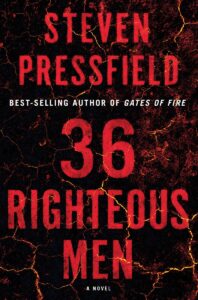NYC Cops and the Case of the Lamed-Vovniks
March 3, 2020 in Library Corner
By Robin Jacobson.
Best-selling author Steven Pressfield was in Israel researching a book when he first heard the legend of the lamed-vovniks, the 36 righteous individuals upon whom the fate of the world rests. Immediately, the irreverent thought popped into his head, “So, what would happen if someone started murdering those 36 guys?” Intrigued, Pressfield began crafting a dystopian thriller, 36 Righteous Men (2019). This clever and imaginative page-turner is available in our library.
36 Righteous Men: The Novel
 Much of the novel’s action takes place in New York City in April 2034, where sweltering daytime temperatures hover around 115 degrees. And that is just one of the brutal consequences of global warming. Devastating superstorms are common; water shortages have led to riots; and millions of inhabitants of Southeast Asia and sub-Saharan Africa have been made refugees by crop failures and famine. But on the upside in this future world, the NYPD has switched to self-driving vehicles, and the Israeli-Palestinian conflict is no more – instead, the two sides work closely to combat climate change.
Much of the novel’s action takes place in New York City in April 2034, where sweltering daytime temperatures hover around 115 degrees. And that is just one of the brutal consequences of global warming. Devastating superstorms are common; water shortages have led to riots; and millions of inhabitants of Southeast Asia and sub-Saharan Africa have been made refugees by crop failures and famine. But on the upside in this future world, the NYPD has switched to self-driving vehicles, and the Israeli-Palestinian conflict is no more – instead, the two sides work closely to combat climate change.
Against this backdrop, New York City homicide detectives James Manning, a hardboiled, veteran cop with a tragic past, and his earnest young partner, Covina “Dewey” Duwai, are called to investigate a series of baffling murders, linked by the letters “LV” branded between the eyes of each victim.
One clue that something otherworldly is afoot comes via an anonymous text to Manning: “LV is Hebrew. The letters “lamed” and “vav.” Google it.” An old-school investigator, Manning goes instead to a Jewish library. There, he encounters a young professor of Judaic studies who explains that the numerical value of the Hebrew letters lamed and vav is “36,” an allusion to the legend of the 36 lamed-vovniks.
Manning and Dewey doggedly pursue the murderer from a boisterous Chassidic farbrengen in Brooklyn to an Israeli archaeological dig, sometimes aided by a disgraced rabbi who may not be revealing all she knows. They posit a connection between the killings and the climate crisis – many of the victims are climate scientists or activists. Soon, the detectives begin to fear that the violent murders may merely be a means to a horrific end; the villain’s ultimate goal may be to destroy the world.
36 Righteous Men: The Legend
The idea that a small number of righteous individuals can save humankind from destruction has its seeds in the Torah. Trying to save Sodom, Abraham bargains, asking if God would spare the city for the sake of 10 righteous persons. However, the Babylonian Talmud is the source for the particular legend of the lamed-vav tzaddikim (lamed-vovniks is the common Yiddish shorthand). According to tradition, there are 36 righteous individuals in every generation, and the world continues because of their merit. They are unknown to each other and even to themselves. For this reason, they are also called the tzadikim nistarim, the “hidden righteous ones.”
A popular motif in Jewish folktales, the legend of the lamed-vovniks was famously reworked in the 20th Century by French novelist André Schwarz-Bart in The Last of the Just. In Schwarz-Bart’s imagining, lamed-vovnik status is passed down through a family of Jewish martyrs. The last of the dynasty dies in an Auschwitz gas chamber.
More recently, artist Peter Leventhal has won accolades for his series of paintings, “Lamed Vav,” portraying the lamed-vovniks as ordinary people from his own life. The beautiful implication of the legend, says Leventhal, is that since there is no way to identify a lamed-vovnik, we must treat each person with the respect due someone who is one of the pillars of the world.